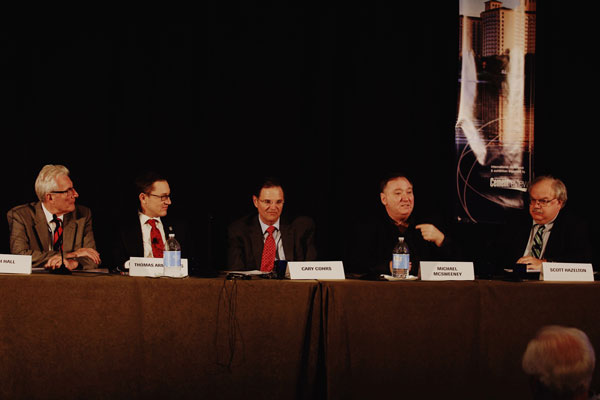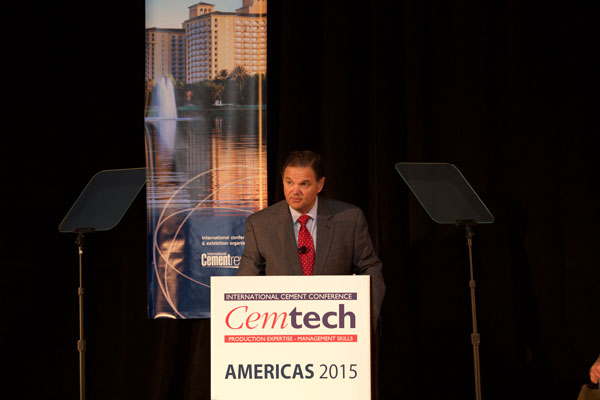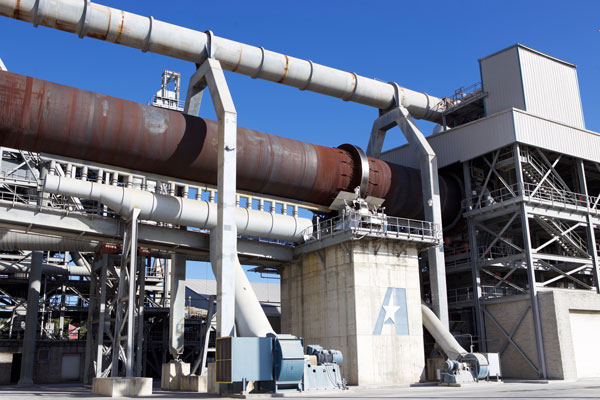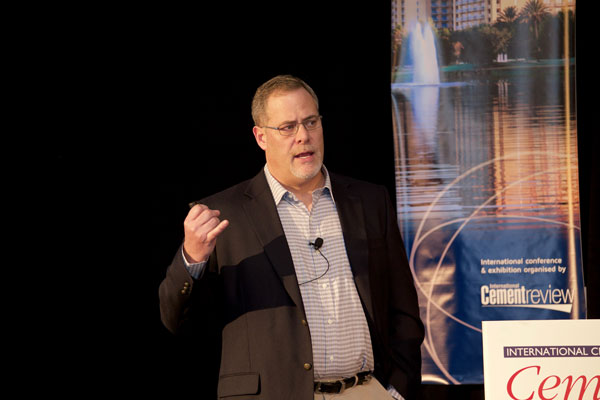Cemtech returns
Cemtech Americas was successfully held at the Ritz-Carlton Orlando, Florida, on 7-10 December 2015, marking the first Cemtech event in North America since 2008. Delegates enjoyed a highly topical speaker programme, site visit to American Cement Co’s Sumterville plant, vendor exhibition and full hospitality programme. Welcome back Cemtech!

Cemtech – back in the USA, leading with key presentations from Cary Cohrs, president and CEO of American Cement
Co; Michael McSweeney, president and CEO of the Cement Association of Canada and Scott Hazelton, IHS Economics
A lot has changed in the seven years since Cemtech last held a conference in the United States. In 2008 the world was in the midst of the global financial crisis which had devastating consequences for the global construction sector, in particular. In the US cement consumption fell by 46 per cent from a peak of 127Mt in 2005 to 69Mt in four years later.

Cary Cohrs, President & CEO of American Cement Co,
delivers the first presentation of Cemtech Americas 2015
with an overview of the host market of Florida
The first morning of the conference, therefore, provided a chance to fully evaluate the current status of the cement sector in the US and wider Americas region. Opening proceedings, Cary Cohrs, president and CEO of American Cement Co LLC, presented a detailed study of the Florida cement sector, where the company operates one of the most modern cement plants in the US.
The state of Florida was one of the hardest hit during the Great Recession, with demand falling by 69.5 per cent from its peak of over 12Mt in 2005 to less than 4Mt in 2010. Since then the economy, now growing at 2.9 per cent – marginally faster than the US as a whole – has seen consumption recover to 6Mt, which is still some way below installed cement capacity of 12.5Mta. Unsurprisingly, cement imports to Florida have all but vanished from the 2005 heyday (5.75Mt) and the state could even become a net exporter.
In his detailed survey of the United States cement sector, Rob Roy of ROI Economic Consulting (USA) stressed that while US consumption has bounced back to growth, consumption remains well below the peak (-29 per cent) and capacity utilisation is now below 60 per cent, versus 90 per cent in 2005.
Currently, the hardest-hit states in the south and west are expanding faster than the northeast and midwest. Texas is seeing some of the strongest growth, in spite of depressed oil prices, on the back of a well-diversified economy. Interestingly, low oil prices are expected to have a net positive effect on the US cement consumption, although clearly not for the energy producing states. Going forward, annual domestic cement demand is expected to grow at around 3-5 per cent.
Scott Hazelton, IHS Economics (USA), provided a range of economic insights and predicted a gradual acceleration for the world economy in 2016. The US will experience gains in housing and business fixed investments and the eurozone should benefit from continued stimulus, he said. On the other hand, he felt China would continue to slow on the back of imbalances in credit, housing and industrial markets. He further added that South America will remain hamstrung by the plunge in commodity prices which will inhibit investment and impact on construction activity. Brazil and Venezuela are expected to experience prolonged recessionary environments, and sub-par growth is anticipated in Chile, Peru and Colombia over 2015-17.

American Cement Co’s 1.1Mta integrated plant at Sumterville, central Florida, hosted the Cemtech plant tour.
One of the most modern facilities in the US, the plant began operations in 2009 and
is a joint venture between Oldcastle MaterialsInc (CRH) and the Stavola family
Francisco Suarez of Scotiabank (Mexico) offered a view of Latin America’s cement markets. The key flashpoints are Brazil, where utilisation now stands at just 59 per cent against the backdrop of a deteriorating market, and Colombia where momentum is currently strong but economic imbalances and excessive capacity may result in pricing reversals in the medium term (2017-18). Francisco was optimistic about Mexico which, for the first time since the crisis, is showing strong growth prospects and pricing momentum.
Reducing carbon emissions
Cemtech Americas took place at the same time as the COP21 climate change meeting in Paris, making the presentation by Michael McSweeney, president and CEO of the Cement Association of Canada (CAC) particularly topical (view the full speech). His important contribution examined the experiences of Canada in its ongoing transition to a low-carbon economy and impact on the cement sector: “In about one year’s time, the vast majority of Canadians, and all but one of Canada’s cement facilities, will live and operate in an economy that has put a price on carbon, either through a carbon tax or as part of a larger cap-and-trade system under the Western Climate Initiative,” he explained.
While cement is a crucial building material, and will remain so as economies modernise, the climate agenda dictates that the cement sector must innovate to remain sustainable. Confident in the ability of the sector to deliver on this “moral imperative”, Michael stated: “I believe in the tremendous innovative power of our sector and that our collective investments in low-carbon technologies will drastically reduce our carbon footprint.”
A definitive presentation on climate change and regulatory developments in the North American cement industry was later given by Josh Snead, an international trade specialist at King & Spalding LLP (US). He described California’s cap-and-trade scheme which is now in its second phase of compliance and is now grappling with the issue of carbon leakage. The industry will have to fight for adjustments to the system that allows imports from less regulated jurisdictions to compete at an unfair cost advantage with the local California producers, he stressed.
Manufacturing technology
As well as keeping delegates updated on market and regulatory developments, the objective of every Cemtech conference is to provide a specialist forum to explore best practice manufacturing technology.
Juan Teevin of Cementos Pacasmayo (Peru) presented an overview of the company’s integrated greenfield Piura cement plant project, which promises to be the most modern plant in Latin America. Equipped with a 3000tpd clinker line and 1.6Mta cement capacity, the new facility will service the high growth markets of northern Peru. The mill is now commissioned using imported clinker and Japanese slag, with final commissioning of the kiln to be undertaken at the start of 2016.
Environmental issues and CO2 reduction
The impact of environmental regulations on the US industry were dealt with superbly by Carrie Yonley, Schreiber & Yonley Associates (USA), one of the foremost authorities in this area of mind-boggling complexity. She reviewed the lessons learned from the PC MACT implementation, which has placed significant pollution monitoring and testing responsibilities on the domestic industry. Looking ahead, Carrie outlined details of the Commercial Industrial Solid Waste Incinerator (CISWI) compliance regime, coming into force in February 2018, which requires kilns that burn solid waste to be categorised as ‘waste incinerators’, and adopt alternative emissions standards and operating limits to those covered by PC MACT. No fuels that are considered solid waste are allowed in a PC MACT kiln.
Luiz Germano, global energy manager of Votorantim Cimentos – Brazil’s leading player and global group with 33Mta capacity – presented a unique study on CO2 reduction. Votorantim’s strategy is to produce a pozzolan clinker substitute from artificial clays located primarily in the west of Brazil in specially-adapted kiln and grinding systems. Over the 2010-15 period, Votorantim has already reduced CO2 emissions by 1.6Mt.
Best practice
Jeff Hook, Senior QC manager at Lehigh North, presented energy efficiency case studies from the Union Bridge plant, one of the company’s best performers. One example showed how the installation of a PGNAA cross belt analyser on the raw mill collection belt ahead of a VRM was used to achieve a more consistent raw meal quality. As the LSF standard deviation was reduced, fuel consumption decreased by 3.9 per cent, resulting in a ROI of less than one year for the project.

Jeff Hook, senior QC manager of Lehigh North, presents energy efficiency case studies
from the Union Bridge plant, one of the company’s best performers
John Kline, Kline Consulting (USA), a regular contributor to ICR, provided a masterclass on understanding and evaluating different cement grinding technologies: from ball mills to VRMs.
Chris Oesch, president of Gebr Pfeiffer Inc, presented the company’s new focus on semi-mobile, modular grinding systems, with an optional swing-mill design allowing the same system to switch between grinding cement, slag, limestone or coal.
Jorg Schrabback, Sika (Germany) – a regular speaker addressing Cemtech for the final time before moving to a new role within his company – presented a typically compelling argument for the use of cement additives. He explained how additives, in the right circumstances, can increase the production rate and strength of cement products, and be used to produce limestone cement with lower clinker content – therefore offering a potentially great saving.
Cenk Alpaslan presented the Fons Delta Cooler, a high-efficiency grate cooler with especially low wear, a special ‘stepped air flow function’ design providing optimal heat recuperation and a unique seal design ensuring no clinker fall through between lanes. A case study was presented showing the retrofit of a cooler for Çimsa, Turkey, in just 11 days.
David Khanna, BPI.Visqueen (UK) and Trevor Mitford, Concetti Group (UK) both exhorted the benefits of polythene packaging, arguing that the material is ideal suited for this purpose as it offers superior strength and weatherproofing over paper alternatives, as well as satisfying a higher consumer preference.
Gerry Lynskey, principal and founder of SSI Consulting (USA), presented an expert guide to inspecting silo storage, highlighting potential issues such as asymmetric flows, overstressing and poor design. To ensure good stewardship and safety, silo owners should engage experts to routinely inspect their facilities, he underlined.
Alternative fuels
John Kline returned to the podium with a presentation outlining a strategic approach to alternative fuels. The presentation highlighted that producers should be able to respond to the changes in fuel availability over time, and be willing to innovate and adopt newer fuels as older ones become popularised and, therefore, more expensive.
The US cement industry is notably behind the curve when it comes to AF utilisation, argued Ed Morton of the Evolution Environmental Group (USA). The United States consumes around 0.3t AF per tonne of cement produced, compared to 0.5t in Europe. Evolution Environmental has worked closely with Titan in the US to build a bespoke separation, shredding, and storage system at the cement producer’s Pennsuco plant, which has achieved a thermal substitution rate of 10 per cent.
Emissions
Other presentations included Gerald Hunt, Lhoist (USA), who showed how dry sorbent injection technology with hydrated lime and Lhoist’s Sorbacal® products could help cement plants comply with HCl and SO2 limits.
Alvaro Linero, Koogler and Associates (US), examined techniques for mercury control in Florida’s eight active kilns.
Networking & hospitality

Legendary Cemtech hospitality was very much in evidence over the three-day event
and culminated in a spectacular Gala dinner on the final evening
The conference was accompanied by an international equipment exhibition featuring leading industry suppliers, plus an extended programme allowed participants to visit to American Cement Co’s Sumterville plant, a world-class cement facility in central Florida. Networking opportunities were further supported by evening receptions, lunches and Gala Dinner, all set against the backdrop of the outstanding Ritz-Carlton Orlando.
Article first published in International Cement Review, February 2016.

